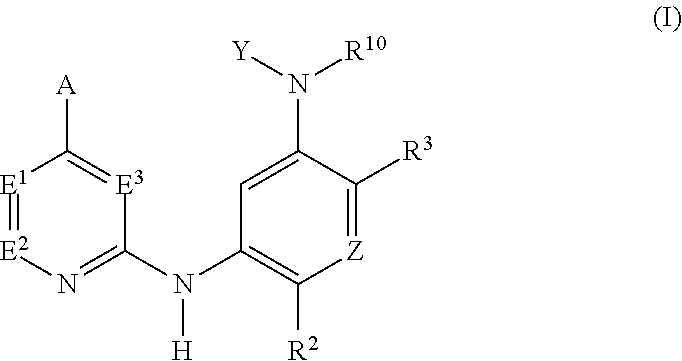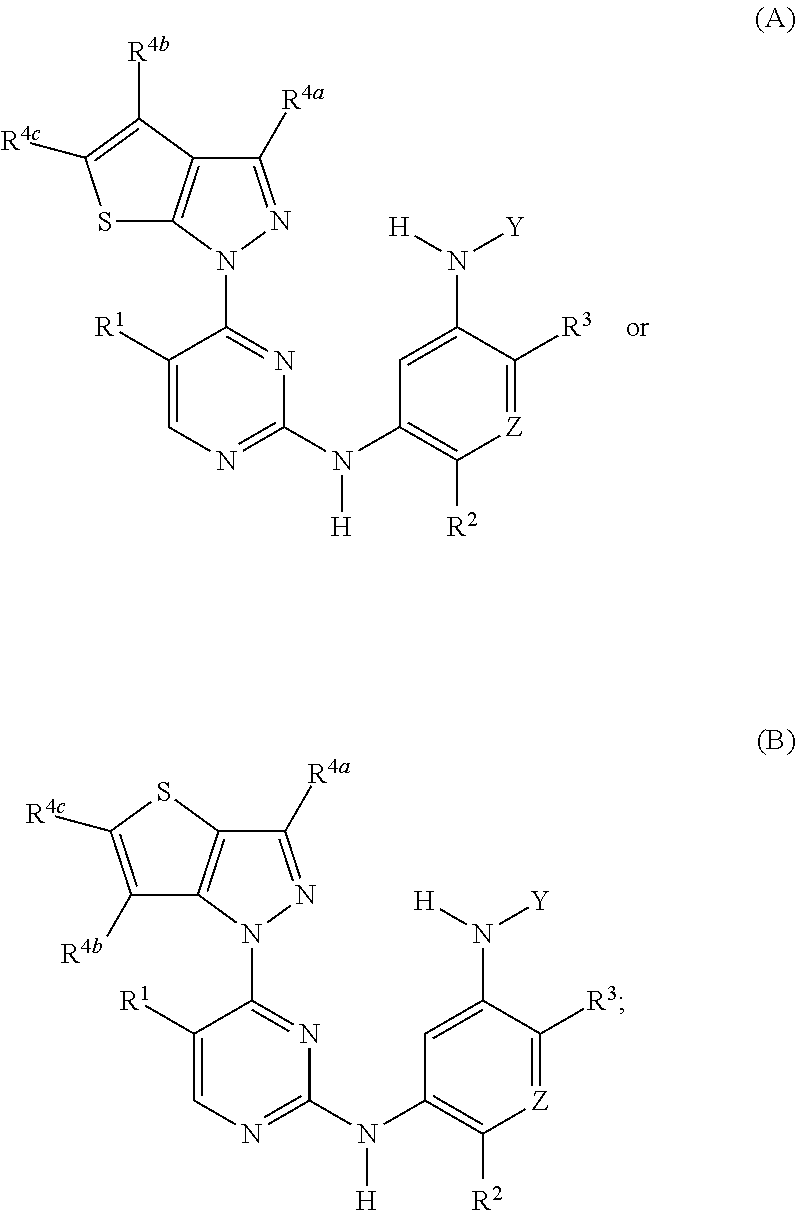Selective inhibitors of clinically important mutants of the EGFR tyrosine kinase
a technology of egfr tyrosine kinase and selective inhibitors, which is applied in the direction of organic chemistry, organic active ingredients, drug compositions, etc., can solve the problems of reducing the normal response of both external signals and tumors, forming tumors, and inhibiting the kinase activity of pks can have very drastic effects on cellular signaling
- Summary
- Abstract
- Description
- Claims
- Application Information
AI Technical Summary
Benefits of technology
Problems solved by technology
Method used
Image
Examples
example 1
(3-(Dimethylamino)-6-methyl-1H-pyrazolo[4,3-c]pyridin-1-yl)pyrimidin-2-yl)amino)-2-((2-(dimethylamino)ethyl)(methyl)amino)-4-methoxyphenyl)acrylamide
[1105]
[1106]2-Chloro-4-(N,N,6-trimethyl-pyrazolo[4,3-c]pyridin-3-amine-1-yl)pyrimidine (120 mg, 0.42 mmol, 1.0 eq), N-(5-amino-2-((2-(dimethylamino)ethyl)(methyl)amino)-4-methoxyphenyl)acrylamide (134 mg, 0.46 mmol, 1.1 eq) and 2-pentanol (2 mL) and p-TsOH.H2O (87 mg, 0.46 mmol, 1.1 eq) were sealed in a 10 mL Schlenk tube. The mixture was stirred at 120° C. for 2 h. After completion, the mixture was cooled to RT and diluted with sat. NaHCO3 (10 mL) and DCM / MeOH (10 / 1, 20 mL), the organic layer was separated and the aqueous layer was extracted with DCM (5 mL×2). The combined organic layers were washed with NaHCO3 (20 mL×2) and brine (20 mL), dried, concentrated and purified by prep-HPLC affording N-(5-((4-(3-(dimethylamino)-6-methyl-1H-pyrazolo[4,3-c]pyridin-1-yl)pyrimidin-2-yl)amino)-2-((2-(dimethylamino)ethyl)(methyl)amino)-4-methoxyph...
example 2
(7-Cyano-1,3-dimethyl-1H-indol-5-yl)pyrimidin-2-yl)amino)-2-((2-(dimethylamino)ethyl)(methyl)amino)-4-methoxyphenyl)acrylamide
[1107]
[1108]To a solution of 2-chloro-4-(7-cyano-1,3-dimethyl-1H-indol-5-yl)pyrimidine (164 mg, 0.58 mmol, 1.0 eq) and N-(5-amino-2-((2-(dimethylamino)ethyl)(methyl) amino)-4-methoxyphenyl)acrylamide (170 mg, 0.58 mmol, 1.0 eq) in 2-pentanol (4 mL) was added p-toluenesulfonic acid monohydrate (123 mg, 0.64 mmol, 1.1 eq). The mixture was heated to 120° C. for 5 h in a 10 mL Schlenk tube. After cooling down to RT, the mixture was poured into water (10 mL), extracted with DCM / MeOH=10:1 (10 mL×3), the combined organic layers were washed with brine (10 mL), dried over sodium sulfate, concentrated and purified by silica column affording N-(5-((4-(7-cyano-1,3-dimethyl-1H-indol-5-yl)pyrimidin-2-yl)amino)-2-((2-(dimethylamino)ethyl)(methyl)amino)-4-methoxy phenyl)acrylamide (48 mg, 15%). 1H NMR (300 MHz, DMSO-d6): δ 10.19 (br, 1H), 9.07 (s, 1H), 8.71 (s, 1H), 8.51-8.4...
example 3
(7-Cyano-3-methyl-1H-pyrrolo[2,3-c]pyridin-5-yl)pyrimidin-2-yl)amino)-2-((2-(dimethylamino)ethyl)(methyl)amino)-4-methoxyphenyl)acryl amide
[1109]
[1110]To a 10 mL microwave tube were added 2-chloro-4-(1,N-(tert-butoxycarbonyl)-7-cyano-3-methyl-pyrrolo[2,3-c]pyridin-4-yl) pyrimidine (90 mg, 0.24 mmol, 1.0 eq), N-(5-amino-2-((2-(dimethylamino)ethyl)(methyl)amino)-4-methoxyphenyl)acrylamide (78 mg, 0.27 mmol, 1.1 eq), 2-pentanol (2 mL) and p-TsOH.H2O (51 mg, 0.27 mmol, 1.1 eq). The mixture was stirred at 170° C. under microwave for 1 h. After completion, the mixture was cooled to RT and diluted with sat. NaHCO3 (10 mL) and DCM / MeOH (10 / 1, 11 mL), the organic layer was separated and the aqueous layer was extracted with DCM / MeOH (5 mL×2). The combined organic layers were washed with NaHCO3 (10 mL) and brine (10 mL), dried, concentrated and purified by prep-HPLC affording N-(5-((4-(7-cyano-3-methyl-1H-pyrrolo[2,3-c]pyridin-5-yl)pyrimidin-2-yl)amino)-2-((2-(dimethylamino)ethyl)(methyl)amino...
PUM
| Property | Measurement | Unit |
|---|---|---|
| Volume | aaaaa | aaaaa |
| Volume | aaaaa | aaaaa |
| Volume | aaaaa | aaaaa |
Abstract
Description
Claims
Application Information
 Login to View More
Login to View More - R&D
- Intellectual Property
- Life Sciences
- Materials
- Tech Scout
- Unparalleled Data Quality
- Higher Quality Content
- 60% Fewer Hallucinations
Browse by: Latest US Patents, China's latest patents, Technical Efficacy Thesaurus, Application Domain, Technology Topic, Popular Technical Reports.
© 2025 PatSnap. All rights reserved.Legal|Privacy policy|Modern Slavery Act Transparency Statement|Sitemap|About US| Contact US: help@patsnap.com



